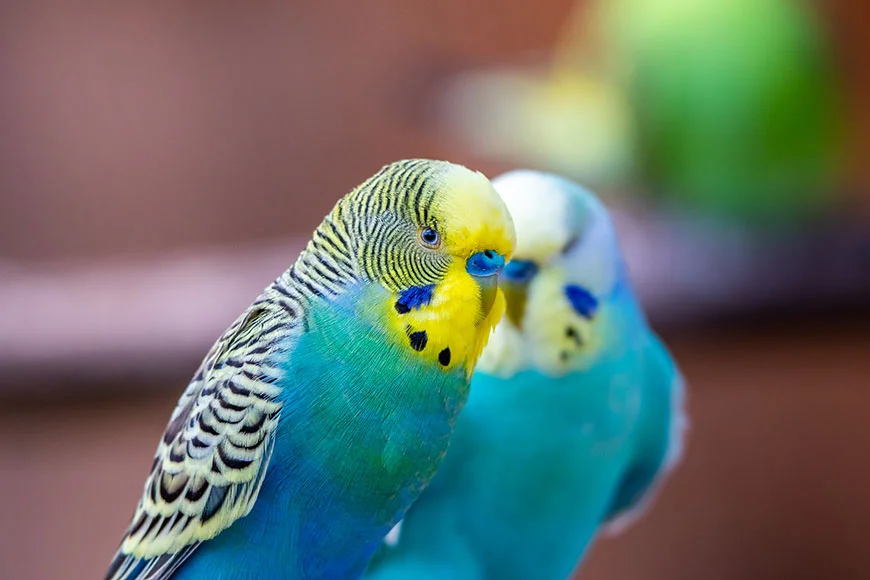The Budgerigar, commonly known as a budgie, is one of the most popular pet birds worldwide. Loved for their vibrant colors, playful nature, and ability to mimic human speech, budgies make fantastic companions. Whether you’re considering bringing a budgie into your home or you’re already a proud budgie owner.
This comprehensive guide will cover everything you need to know—from their history to their care and behavior.
A Brief History of the Budgerigar
The Budgerigar, a small parrot native to Australia, has a rich history dating back millions of years. Europeans first discovered budgies in the late 18th century, but they had long been a part of Indigenous Australian culture. Wild budgies, which are green and yellow, roamed the Australian outback in large flocks.
These birds were later bred in captivity, leading to the variety of colors seen in pet budgies today. In the 1840s, budgerigars were brought to Europe, where they quickly gained popularity as pets. Today, they are beloved around the globe for their friendly nature and colorful appearance.
Physical Characteristics of Budgerigars
| Feature | Description |
| Size and Weight | 7 inches in length, 1 to 1.4 ounces |
| Color Varieties | Green, yellow, blue, white, purple |
| Wingspan | 10 to 12 inches |
| Beak and Feet | Strong, curved beaks; zygodactyl feet (two toes forward, two toes backward) |
Temperament and Personality of Budgerigars
Budgerigars are known for their lively and social personalities. They are curious and playful and enjoy interacting with their human companions.
- Social Nature: Budgies thrive on social interaction with their owners and other birds. They enjoy chirping, playing with toys, and even mimicking sounds or speech.
- Intelligence: With proper training, these little parrots are quite intelligent and can learn to perform tricks or mimic human words.
- Affectionate Companions: Budgies form strong bonds with their owners and can become very affectionate, often sitting on shoulders or perching on fingers.
- Playful Behavior: Budgies love to play. They enjoy exploring their environment, playing with toys, and engaging in activities that stimulate their minds.
Health and Lifespan of Budgerigars
| Aspect | Details |
| Common Health Issues | Respiratory infections, mites, obesity |
| Preventive Care | Regular vet check-ups, clean environment, balanced diet |
| Lifespan | 7 to 15 years, potentially longer with optimal care |
Housing and Environment for Budgerigars
Creating a comfortable and stimulating environment for your budgie is crucial to their well-being.
- Cage Size: Budgies need a spacious cage to stretch their wings and move around freely. A cage at least 18 inches wide, 18 inches deep, and 24 inches high is recommended for a single budgie.
- Perches and Toys: Provide various perches of different sizes and textures to help maintain their feet’ health. Toys like mirrors, bells, and chewable items keep them mentally stimulated and prevent boredom.
- Lighting and Temperature: Budgies prefer a well-lit area that mimics their natural environment. Keep their cage in a room with plenty of natural light, but avoid direct sunlight. The ideal temperature range for budgies is between 65°F and 75°F.
- Cleanliness: To maintain a healthy environment, regularly clean the cage, food and water dishes, and perches. Change the cage liner at least once a week.
Diet and Nutrition Tips for Budgerigars
| Food Type | Importance |
| Seed Mixes | It should be supplemented with other foods |
| Pellets | It should make up about 50-60% of the diet |
| Fruits and Vegetables | Fresh, offered daily; remove uneaten portions |
| Calcium Sources | Cuttlefish bones or mineral blocks for strong bones and beak health |
| Water | Fresh, clean water is available at all times, changed daily |
Training and Socialization of Budgerigars
Budgerigars are intelligent birds that can be trained to do tricks and even talk.
- Basic Training: Start with simple commands like “step up” to encourage your budgie to hop onto your finger. Patience and consistency are key.
- Talking: Male budgies are known to be better talkers, but with regular interaction, both male and female budgies can learn to mimic words. Repetition and positive reinforcement work best.
- Socialization: Gradually introduce your budgie to new people, environments, and experiences to help them become well-adjusted and confident.
Exercise and Activity Needs
Budgerigars are active birds that need plenty of opportunities to exercise.
- Flying Time: Allow your budgie out-of-cage time daily to fly and explore in a safe environment. This exercise is crucial for their physical and mental health.
- Interactive Play: Engage with your budgie through games and toys. They enjoy puzzles, foraging toys, and anything that stimulates their curiosity.
- Social Interaction: Budgies are social creatures and need regular interaction with their owners or other budgies. Spend time talking to and playing with your bird daily.
How to Care for Budgerigars: Major Tips
Proper care is essential to keeping your budgie happy and healthy.
- Regular Vet Visits: Schedule annual check-ups with an avian vet to catch potential health issues early.
- Grooming: Budgies usually keep themselves clean but enjoy a mist bath or a shallow dish of water to bathe in. Keep their nails trimmed, and be mindful of their beak and feather condition.
- Mental Stimulation: Regularly introduce new toys and rotate them to stimulate your budgie mentally. Boredom can lead to behavioral issues like feather plucking.
Why Budgerigars Make Great Pets
Budgerigars are ideal pets for both first-time bird owners and experienced bird lovers.
- Affordability: Budgies are relatively inexpensive to buy and maintain than larger parrot species.
- Low Maintenance: They don’t require as much space or specialized care as larger birds, making them easier to manage in smaller homes or apartments.
- Personality: Despite their small size, budgies have big personalities. They’re interactive and engaging and can bring a lot of joy to your life.
- Longevity: With proper care, budgies can be long-lived companions, forming deep bonds with their owners.
Fun Facts About Budgerigars
Budgerigars are fascinating creatures with some interesting quirks!
- Mimicry: Budgies are among the best mimics in the bird world. Some can learn up to 100 words and phrases!
- Color Vision: Budgies can see ultraviolet light, which is invisible to humans. This ability plays a role in their social interactions and mating behavior.
- High-Flying Birds: In the wild, budgies can fly up to 30 mph and cover hundreds of miles searching for food and water.
Final Thoughts
Budgerigars are not just beautiful and entertaining; they are also intelligent and affectionate pets. Whether you’re drawn to their playful nature, ability to mimic speech, or vibrant colors, budgies make excellent companions. You’ll be rewarded with a happy, healthy bird that brings joy to your home by providing them with the right environment, diet, and care. This guide has covered everything you need to know about budgerigars, from their history and physical traits to their care and training. Here’s to a long and happy relationship with your feathered friend!



